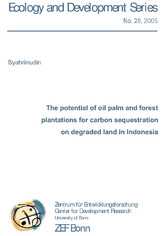Suchen und Finden
The potential of oil palm and forest plantations for carbon sequestration on degraded land in Indonesia
Mehr zum Inhalt

The potential of oil palm and forest plantations for carbon sequestration on degraded land in Indonesia
Plant biomass represents a sink for atmospheric carbon dioxide, which is one of the most important greenhouse gases and which is assumed to contribute more than half of the global warming. Establishing tree plantations or perennial crops on degraded land is an effective way to reduce atmospheric carbon by building up terrestrial carbon stocks, not only in the living biomass, but also in the soil. By converting Imperata cylindrica grassland into tree plantations (Acacia mangium or oil palm), aboveground biomass carbon can be increased about 20-fold and belowground biomass carbon up to 8-fold, while soil carbon can almost be doubled.
Alle Preise verstehen sich inklusive der gesetzlichen MwSt.










